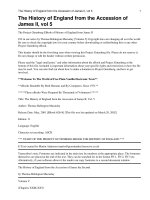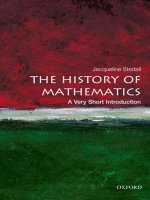010 lessons from the history of mathematics
Bạn đang xem bản rút gọn của tài liệu. Xem và tải ngay bản đầy đủ của tài liệu tại đây (1.61 MB, 31 trang )
Lessons from the History of
Mathematics
Tom Osler
Rowan University
Is Mathematics a Humanity or a
Science?
• Humanities
• The branch of learning regarded as having
primarily a cultural character and use,
including languages, literature, history and
philosophy.
• Sciences
• A branch of study that is concerned with
observation and classification of facts, and
especially with the establishment or strictly
the quantitative formulation of verifiable
general laws by induction and by hypothesis,
Introduction
•
•
•
Teaching math history for about 20 years
I am not a historian
Some of the opinions expressed are my
personal view
We discuss only Higher
Mathematics
• Every civilization needed a simple number
system and primitive geometry
• This is NOT what we discuss
• Higher Mathematics
• Algebra, Trigonometry, Geometry with
proofs, Calculus etc
The 5 minute history of math
• There were only two principle explosions of
mathematical creativity
• Greek 600 BC to 200 AD
• European 1500 to today
The 5 minute history of math
• Today math research is performed all over
the world by both men and women
• This was not true only 40 years ago, when
most researchers were men with names of
European descent
• Note: Until 1800, mathematicians were known
as “Geometers”, not mathematicians
Lesson 1 The fragility of
mathematics
• Few cultures nourished math
• Most people born with math gift never had a
chance to develop it
Lesson 2 Motivation for doing
math
•
•
•
•
•
•
•
Play
Challenge problems
Exploring the mind of God
Pythagorians 580-500 BC
Everything is number
Ptolemy ca 85-185 AD
Kepler 1571-1630
Quote from Ptolemy
• I know that I am mortal and the creature of a
day; but when I search out the massed
wheeling circles of the stars, my feet no
longer touch the earth, but, side by side with
Zeus himself, I take my fill of ambrosia, the
food of the gods.
Quote from Kepler
•
“Why waste words? Geometry existed
before the Creation, is co-eternal with the
mind of God, is God himself (what exists in
God that is not God himself?); geometry
provided God with a model for the Creation
and was implanted into man, together with
God’s own likeness-and not merely conveyed
to his mind through the eyes”
Lesson 3
Math is unlike any other academic study
•
Does not change
•
Euclid’s Elements
•
No errors for 2300
years
•
God is a Mathematician
William Blake 1757-1827
William Blake: The Ancient of Days
William Blake: Newton
The Tyger
by William Blake
•
Tyger! Tyger! burning bright,
In the forests of the night,
What immortal hand or eye
Could frame thy fearful symmetry?
• In what distant deeps or skies
Burnt the fire in thine eyes?
On what wings dare he aspire?
What the hand dare seize the fire?
• And what shoulder, and what art?
Could twist the sinews of thy heart?
And when thy heart began to beat,
What dread hand, and what dread feet?
What the hammer? What the chain?
In what furnace was thy brain?
What the anvil? What dread grasp
Dare its deadly terrors clasp?
• When the stars threw down their spears,
And watered heaven with their tears,
Did he smile his work to see?
Did he who made the Lamb, make thee?
Tyger! Tyger! burning bright,
In the forests of the night,
What immortal hand or eye
Dare frame thy fearful symmetry?
Lesson 4 The mother of
mathematics is astronomy/astrology
•
•
•
•
•
•
Babylonian planet and star charts
Greek Astronomy
Eratosthenes 276-194 BC
measures earth diameter
(error 5%)
Hipparchus 190-120 BC
distance to moon (error 5%)
and to sun (error 2000 %)
Lesson 4 The mother of
mathematics is astronomy/astrology
• Motion of Sun, Moon, Planets and Stars
– Develop Calendar of Seasons
• Month – Lunar cycle
• Year – Solar cycle
– Predict future events – Astrology
• Positions of Sun, Moon and Planets on the Ecliptic
Zodiac
Retrograde Motion of Mars
•
•
•
•
•
•
•
•
•
Apollonius 256-190 BC
invents epicyclic motion
/>
Ptolemy – Almagest 150 AD
Earliest trig tables
Predicts planet positions with
an accuracy one degree in
100 years









